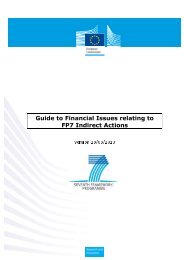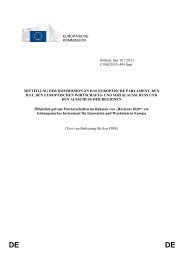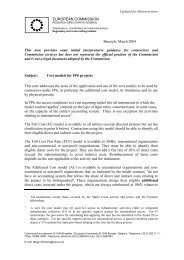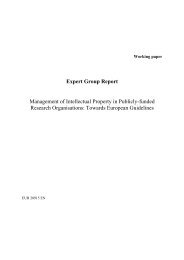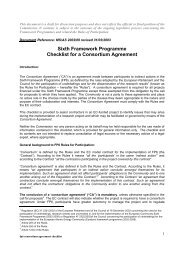Joint Ownership in Intellectual Property Rights - KoWi
Joint Ownership in Intellectual Property Rights - KoWi
Joint Ownership in Intellectual Property Rights - KoWi
Create successful ePaper yourself
Turn your PDF publications into a flip-book with our unique Google optimized e-Paper software.
The IPR-Helpdesk is a project of the European Commission DG Enterprise,<br />
co-f<strong>in</strong>anced with<strong>in</strong> the fifth framework programme of the European Community<br />
<strong>Jo<strong>in</strong>t</strong> <strong>Ownership</strong> must be dist<strong>in</strong>guished from other circumstances.<br />
- Collective works: French law provides specific rules for so-called collective works. Under French law, a collective<br />
work is a work created at the <strong>in</strong>itiative of a natural or legal person who edits it, publishes it and discloses it under<br />
his direction and name and <strong>in</strong> which the personal contributions of the various authors who participated <strong>in</strong> its production<br />
are merged <strong>in</strong>to the overall work for which they were conceived, without it be<strong>in</strong>g possible to attribute a<br />
separate right to each author <strong>in</strong> the work created. Two conditions must be fulfilled: First the work has to be created<br />
at the <strong>in</strong>itiative or under the direction of a natural or legal person and secondly the contributions must have<br />
merged prevent<strong>in</strong>g separate rights from be<strong>in</strong>g attributed to the common work.<br />
The term collective work is often used for a work that is created on the <strong>in</strong>itiative of a legal person (<strong>in</strong> most cases a<br />
company). This person will own the rights by virtue of law and will not have to demonstrate any transfer of rights<br />
provided <strong>in</strong> the employment contract. The legal person still has to demonstrate its <strong>in</strong>itiative and its lead<strong>in</strong>g role <strong>in</strong><br />
the elaboration of the work. Furthermore, it must edit, publish or disclose the work <strong>in</strong> its name.<br />
The work will be collective if it's not possible to attribute a separate right to the work created to each author. This<br />
condition is highly controversial and is subject to different <strong>in</strong>terpretations <strong>in</strong> French case law. Some focus on the<br />
criteria of an absence of cooperation between the authors, others focus on the lack of dist<strong>in</strong>ction between the<br />
contributions. F<strong>in</strong>ally, the ma<strong>in</strong> characteristic of a collective work is the fact that it is the project of a s<strong>in</strong>gle person<br />
(legal or natural). For example, dictionaries, encyclopedia, and newspapers will all be deemed collective.<br />
A collective work is the property of the natural or legal person under whose name it has been disclosed. The author's<br />
rights are vested <strong>in</strong> this person. The legal or natural person will be the orig<strong>in</strong>al owner of the rights. This<br />
ownership <strong>in</strong>cludes patrimonial rights and as well as moral rights.<br />
The author has the right to make a collection of his articles and speeches and the right to publish them or to authorize<br />
their publication <strong>in</strong> this form. The author also has the right to reproduce or to exploit his work published <strong>in</strong><br />
a newspaper or a periodical <strong>in</strong> any form whatsoever, on condition that such reproduction or exploitation does not<br />
compete with the newspaper or periodical concerned.<br />
Basically the scope of this rule is limited to contributions to newspapers or magaz<strong>in</strong>es, but some French courts<br />
tend to extend this rule to all collective works as far as the contribution can be ascerta<strong>in</strong>ed.<br />
- Composite work or derived work: Under French law, a composite work is a new work <strong>in</strong>to which a preexist<strong>in</strong>g<br />
work is <strong>in</strong>corporated without any collaboration between the authors. The composite work is the property of the author<br />
who has produced it, but subject to the rights of the author of the pre-exist<strong>in</strong>g work. The author of the new<br />
work has the exclusive rights of an author, but has to take <strong>in</strong>to account the rights of the author who made the preexist<strong>in</strong>g<br />
work. In other terms, the exploitation of the derived work will be subject to the consent of the author of the<br />
preexist<strong>in</strong>g work.<br />
cc) Italian copyright law<br />
Article 2580 of the Italian Civil Code states that copyright is conferred on the author and, exclusively for the economic<br />
aspect, on his right holders with limitations as provided by special regulations. The Italian <strong>Intellectual</strong> <strong>Property</strong> Law<br />
def<strong>in</strong>es four different notions concern<strong>in</strong>g works created by more than one author. Article 7 of the Law deals with collective<br />
works (opere collettive), i.e., works that are the unitary result of the contributions of various authors work<strong>in</strong>g <strong>in</strong><br />
collaboration and coord<strong>in</strong>ated by a third person other than the authors. Article 10 of the Law deals with works of jo<strong>in</strong>t<br />
authorship (opere <strong>in</strong> comunione), i.e., works that are the unitary result of the contributions of various authors work<strong>in</strong>g<br />
<strong>in</strong> collaboration. In Article 18 we have the notion of <strong>in</strong>dependent works (opere elaborate). This is the case of an author<br />
who elaborates on an already exist<strong>in</strong>g work to form a new one. F<strong>in</strong>ally, Articles 33 to 37 deal with composite<br />
works (opere composte), i.e., works that <strong>in</strong>clude other works created by various authors. In the follow<strong>in</strong>g sections<br />
each of the above situations will be expla<strong>in</strong>ed <strong>in</strong> order to illustrate how co-ownership is regulated under the Italian <strong>Intellectual</strong><br />
<strong>Property</strong> Law.<br />
(1) The ma<strong>in</strong> pr<strong>in</strong>ciples are:<br />
Art. 10 of the Italian <strong>Intellectual</strong> <strong>Property</strong> Law regulates works of jo<strong>in</strong>t authorship, where every author's contribution is<br />
dist<strong>in</strong>guishable and recognizable. If the work has been made by undist<strong>in</strong>guishable and <strong>in</strong>divisible authors' contributions,<br />
copyright will belong to all of the co-authors. The second paragraph of Article 10 confers the Community regime<br />
on works of jo<strong>in</strong>t authorship, stat<strong>in</strong>g that <strong>in</strong>divisible contributions to a work are considered equal contributions, <strong>in</strong> the<br />
absence of an agreement stat<strong>in</strong>g otherwise. The Italian regime allows s<strong>in</strong>gle authors to exercise their moral rights <strong>in</strong>dividually.<br />
Moreover, a work can't be published, modified or exploited differently from the first publication or without<br />
the co-authors' agreement. Unjustified opposition to publication by one or more authors will result <strong>in</strong> the publication,<br />
modification or exploitation be<strong>in</strong>g allowed by the judicial authority.<br />
Art. 10 of the Italian <strong>Intellectual</strong> <strong>Property</strong> Law focuses on collaboration, which means different cases of two or more<br />
authors work<strong>in</strong>g together to produce a work. The common work of the authors can take different forms and each contribution<br />
may be dist<strong>in</strong>guishable and separable, or not. For example, when two persons exchange their op<strong>in</strong>ions and<br />
then write an article together, each one's contribution is neither dist<strong>in</strong>guishable nor separable and we have the case<br />
of a work of jo<strong>in</strong>t authorship. A work of jo<strong>in</strong>t authorship will also arise <strong>in</strong> the case of a comic, where the designer and<br />
the text writer work together, by contribut<strong>in</strong>g to the f<strong>in</strong>al work <strong>in</strong> a dist<strong>in</strong>guishable but not separable way. F<strong>in</strong>ally, we<br />
even have a work of jo<strong>in</strong>t authorship <strong>in</strong> the case of a musician and a lyrics writer, who writes the music and the lyrics<br />
- 4 -



